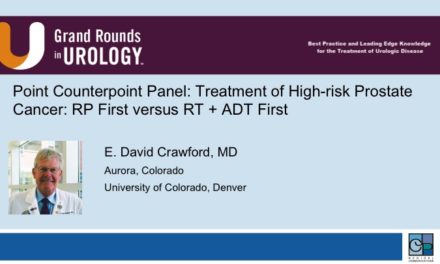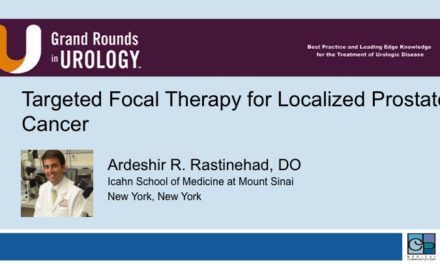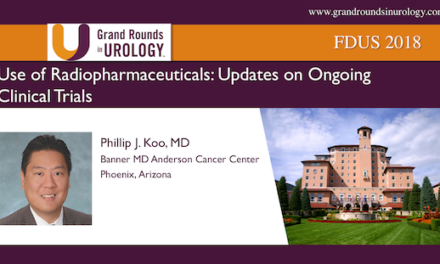Dr. E. David Crawford spoke at the 25th International Prostate Cancer Update on Saturday, January 24, 2015 on “Radiopharmaceuticals: The Past 25 Years and The Future.”
Keywords: radiopharmaceuticals, bone metastases, prostate cancer, Docetaxel, ADT
How to cite: Crawford, E. David. “Radiopharmaceuticals: The Past 25 Years and The Future” Grand Rounds in Urology. March 20, 2015. Accessed Nov 2024. https://dev.grandroundsinurology.com/prostate-cancer-e-david-crawford-radiopharmaceuticals/.
Transcript
Radiopharmaceuticals: The Past 25 Years and The Future
More than 90% of men with symptomatic metastatic castrate resistant prostate cancer have radiologic evidence of bone metastases. A couple of years ago at this meeting, we got together a group of experts and it was called the Radar group and it was radiologic assessment of distant disease. And we came up with guidelines on when to do scanning. It was very interesting, and a number of studies that were done where men were thought not to have metastases. One of those was the IMAGINE study that we do with Janssen with abiraterone in the pre-metastatic prechemo space. About 35% to 40% of men who we thought did not have metastases did have metastases.
Identifying metastases is sort of a seminal event and we’ve improved on that, we had some discussion earlier about using sodium fluoride PET scans and other things to detect metastases. The issue is all our studies are based on technetium scans on what we do today. We may be introducing actually something good but may also be a very significant lee time bias that we’re introducing if we start using all these other scans to detect metastases and so forth. But I think we have to–half of the people that have mets in the castrate resistant space are men that have PSAs of less than 10. So we have to have this sort of looking out, looking out for these events to occur and they do occur quite frequently.
Now we’re going to talk a little bit about mets and the fact that we know that the five year relative survival rates for prostate cancer local regional even lymph nodes is nearly 100%. However, once you have disease that enters into the bone, it’s a game changer and at that point only a quarter of the people will survive five years. We think that’s improving a lot, but these are the old data relative to that.
We know that there are all sorts of variations and consequences of bone mets. We see people that have super scans that have no symptoms. We have people that have one lesion that are in dire pain with symptoms. But we know that bone disease can result in severe pain, it’s significant that you’ve got to double whammy that occurs here with prostate cancer. You have androgen deprivation therapy which is inducing treatment induced bone loss by low T. But we also have pathologic fractures that occur because of where the disease is, and because of ADT, androgen deprivation therapy. We also know that one of the most serious and dreaded event in prostate cancer is spinal cord compression from involvement directly or from fractures, and mostly paraplegia. It’s an emergency. We still see those. We saw a lot of them when I was a resident. They’re still around. One of the drugs that I’ll talk about Radium 223 in the ALSYMPCA trial actually reduced the rate of this event happening. Also you can have your marrow packed with prostate cancer have an effect on your white blood cells and so forth. That is something that is around.
The Curies, Madam Curie in the late 1800s and then in 1903 when she presented her doctoral theses also got a Nobel Prize for describing Radium. Radium was felt to be one of the significant events and it was maybe a cure for cancer back then. We all know that that was not the case and that a lot has changed in the way of radiation therapy and radiation oncology. In fact it was a step forward.
Those of you that remember this from chemistry will remember the periodic table. A lot of these drugs that we’re talking about follow calcium, all right. Calcium is turned over in bone, and what we see is integration of that into bone and so these drugs like strontium mimic calcium. Barium and radium. Samarium doesn’t but if you hook it up to something that acts like calcium, it gets into the bone. So all these things that we’re talking about here, these radiopharmaceuticals mimic calcium.
Strontium-89 is as you saw in that periodic table, is a calcium homologue so tracks calcium deposition and turnover which is occurring in men who have bone mets, and in women with breast cancer, men and women with other cancers. Samarium is hooked up with EDTMP so it mimics calcium. That way it tracks the bone. Phosphorus-32, I’m not going to mention much about that. That’s what I had when we were residents is an effective but extremely toxic radiopharmaceutical.
Now strontium, I mentioned this in my opening talk, was developed in the late 80s and 90s and the pivotal trial was done by Arthur Porter, it was called the TransCanada trial. It took a small number of men, 126, and randomized them to strontium-89 plus local field radiation versus placebo and local field radiation. The primary endpoint was not survival but it was pain.
Then this TransCanada study reported by Porter in 1993, what we’re seeing, that was back in this time, and this is really in the pre-PSA era too. It was effective in reducing bone pain with a P value in that small number of patients, 0.002.
Now the problem with the radiopharmaceuticals back then, and still, is the hematological toxicity which can be significant. With Strontium-89 compared to placebo there was 10% grade 4 platelet toxicity versus just under 2% with the placebo. Same thing with white blood cells. Now samarium had a little bit less in the studies that were done back in the 90s also.
How these things work, the alpha-emitting drugs, and then we’ll talk about the beta-emitting drugs are they are tracked to the tumor and they release their energy. They have different actions. If we look at sort of a cartoon of the size of a beta particle, it might be the size of a BB where the size of a alpha particle is much larger and is such that you can imagine that the penetration of the smaller particles through the bone, into the bone marrow is more significant with a beta particle than it is with an alpha particle. So Neal Shore used this example of throwing a beach ball against the screen versus a BB. You’d have to be pretty strong to get a beach ball to do anything, so I think it was like throwing a basketball hard against the screen. It’s going to dent the screen but it’s not going to go through it. If you shoot a BB in there, it’s going to go through it. So they’re a little different in their power behind them. One packs more punch but it doesn’t have a deep punch.
If you look at relative particle mass here of alpha versus beta particles, you can see that 7,300 versus 1. If you look at the energy that is released, it’s more significant with an alpha particle than it is with the beta particle. If you look at the penetration that occurs, the difference between alpha and beta particles, a significant difference in how deeply it penetrates, so again the disadvantage of the beta particles have to do with the fact that they’re deeper penetrating and can cause more hematological and bone marrow side effects.
Now the second thing is, is that what we’re trying to do is rid the patient of the tumor and have more bone healing and things occur. With beta particles, beta particles are powerful particles, but they usually don’t cause double stranded DNA breaks. You can repair a single strand at break.
If you have a double stranded break, you don’t usually repair that effectively so it’s more lethal and more difficult to repair when you use an alpha particle compared to a beta particle.
And again, this is sort of the same sort of thing, it has to do with the amount of energy that occurs when you use a beta particle versus an alpha particle, and the effects it has.
If we go ahead and sort of summarize this in this table, with all the things that are out there from going back and looking at phosphorus, samarium, strontium, what we see here is the level of energy that is present with radium is on the relative scale of 27 to 1.46 for strontium, and 0.81 for samarium and 1.71 for a relatively toxic drug and that is phosphorus.
Again, so this is more of a short range lethal double stranded DNA break that occurs. This is new in the last 25 years. We’ve been talking at this meeting about this strontium and samarium and trials with that, and that sort of lost its shine for a while. Then along came sort of the rediscovery of radium and integration into trials.
Let’s talk about those trials. We have the trial that was done. First of all it was a phase 2 trial which showed that radium-223 compared to a placebo worked. That’s the right way to do trials, phase 1, phase 2. The next one is a phase 3 trial.
The phase 3 trial is called the ALSYMPCA trial which means ALpharadin in SYMptomatic Prostate Cancer. I like the term alpharadin and the term that… the name that was assigned by the FDA was Xofigo. I use radium-223 a lot when I talk about it. This is a trial that was designed to look at normal care but using radium-223 versus a placebo, with the endpoint being survival. Other things that were looked at we’ll talk about in a minute.
I was actually involved in the design of this trial and I was not in favor of it. I thought that there was no going to be any chance that this drug would have an effect on survival. Anyway, so it was almost over 900 patients. They had a bone mets. No visceral mets. You could have lymph node disease, small lymph nose disease, and you could have docetaxel, most people were supposed to have it, or unfit for docetaxel but most of the time people didn’t want it. Or it wasn’t available where a lot of the sites were in Europe where this was done. Then they were stratified based on alkaline phosphatase, things like that.
The endpoints were overall survival rate. Then other things were looked at, including alkaline phos progression, PSA progression, quality of life. It was about three years ago I think I remember, maybe four years ago, I got a phone call at Christmas time from then the medical director of the company. He said, and Beyer was sort of comarketing this, and he said, they just stopped the study, the Data Safety Monitoring Committee. I said, oh my God, this is being sat, this drug is toxic. He said, no, there was a survival benefit. We were all shocked. It was presented at this meeting for the first time to see something like that.
If you look at this, it is a good study. It’s well balanced. You can see the median age is 71 in both arms, alkaline phosphatase elevation in half the patients. This is important. Everybody thinks that this drug sort of should be… not everybody, there are a lot of people sort of focus on men circling the drain with the disease so to speak, post docetaxel. As you can see here, 40 some percent of the men had not had prior docetaxel, and almost half of them were not taking opiates. They were taking some pain medication. This is not just for people that are far advanced with the disease. You can see a lot of them here metastases, extensive metastases.
There were two results that have been reported. One was a planned interim analysis. That was the one that closed the study in December. And that one showed a significant survival benefit. Now by the time you get the word out, stop the other people in the drug, the people on placebo, whatever, there’s some time. So during that time they gathered more information that was called an exploratory updated analysis. That one actually gave one of the more significant differences; both of them had a significant difference in survival rate 11.3 versus 14.9 months.
Here is the updated analysis. As you can see here, a significant difference in overall survival rate which was the endpoint of the study.
Then it was looked at prior docetaxel and no prior docetaxel. You can expect as you have a better outcome in people that had no prior docetaxel but it was still there in both groups.
And they had something called SRE, skeletal related events, and then symptomatic skeletal related events. Both were improved with this drug.
The safety profile was there. Both adverse events were actually the same, pretty much in the placebo as they were in the radium-223. As a matter of fact, some of the hematological toxicities were more in placebo than it was with radium 223.
The other issue was can you give the drug after man have had chemotherapy, after they’ve had radium worrying about the bone marrow. In fact, what we’re seeing is they did that, and there was not a significant increase in toxicity.
So radium-223, how is it given? You don’t give it in your office. You don’t send them to Walgreens to get the script. It’s usually done and it’s done either through a radiation oncologist which is about half of how it’s used in the United States, or nuclear medicine. We do it through nuclear medicine, we have a treatment plan, and our EPIC order it. They come in, the drug’s ordered, they get it, for six months they get it once a month. It’s a quick 60 second IV infusion by the radiation oncologist or nuclear medicine folks. You do check CBCs before. We’ve been checking them and had not seen any issues but you should be looking at platelets and things like that.
So finishing up here, Neal’s going to talk about this, but we have all these new drugs now that have a survival benefit and they’re all different. And radium-223 is different, so that’s what’s happened in the past 25 years.
What I think going forward is, what we learned from this trial is that radium-223 is a game changer, relative prolonging survival. It reduces skeletal related events, and symptomatic skeletal events, and it was well tolerated. Much more so than we saw with the other things.
Now we have all these new studies out there that Dan showed, and Neal is going to talk about, and how we sequence this in the future, all these things are moving up further. Dan and I had a meeting earlier in this meeting where we talked about the kitchen sink protocol where we’re going to take newly diagnosed metastatic patients and throw the kitchen sink at them. That means that they’re going to be looking at hormonal therapy, combined androgen blockade while they’re going to get chemotherapy early based on the study that Dan showed, the ECOG study. They’re going to get some of the 17 hydroxylase inhibitors, abiraterone. They’re going to get radium-223 early. They’ll have bone protection. The primary is going to be treated, and I think about either how we sequence in drugs like enzalutamide or ARN509 as we go forward.
This I think is the future, it’s going to be… and it’s not going to be they’re going to get this forever, it’s going to be short term. Every cancer that we cure with chemotherapy, it’s not one drug, it’s not two drugs, it’s three or four. And the treatment is not lifetime; it’s usually for a definitive period of time. So that’s where we go from here so that for the future it may not be the ultimate question of sequence. It may be a question of overlay, so how these things, it’s not A, B, C and D. It’s how they go forward.
References
Brechbiel MW. Targeted alpha-therapy: past, present, future? Dalton Trans. 2007 Nov 21;(43):4918-28.
http://www.ncbi.nlm.nih.gov/pubmed/17992276
Bruland ØS, Nilsson S, Fisher DR, et al. High-linear energy transfer irradiation targeted to skeletal metastases by the alpha-emitter 223Ra: adjuvant or alternative to conventional modalities? Clin Cancer Res. 2006 Oct 15;12(20 Pt 2):6250s-6257s.
http://www.ncbi.nlm.nih.gov/pubmed/17062709
de Bono JS, Oudard S, Ozguroglu M, et al. Prednisone plus cabazitaxel or mitoxantrone for metastatic castration-resistant prostate cancer progressing after docetaxel treatment: a randomised open-label trial. Lancet. 2010 Oct 2;376(9747):1147-54.
http://www.ncbi.nlm.nih.gov/pubmed/20888992
de Bono JS, Logothetis CJ, Molina A, et al. Abiraterone and increased survival in metastatic prostate cancer. N Engl J Med. 2011 May 26;364(21):1995-2005.
http://www.ncbi.nlm.nih.gov/pubmed/21612468
Henriksen G, Breistøl K, Bruland ØS, et al. Significant antitumor effect from bone-seeking, alpha-particle-emitting (223)Ra demonstrated in an experimental skeletal metastases model. Cancer Res. 2002 Jun 1;62(11):3120-5.
http://www.ncbi.nlm.nih.gov/pubmed/12036923
Henriksen G, Fisher DR, Roeske JC, et al. Targeting of osseous sites with alpha-emitting 223Ra: comparison with the beta-emitter 89Sr in mice. J Nucl Med. 2003 Feb;44(2):252-9.
http://www.ncbi.nlm.nih.gov/pubmed/12571218
Kassis AI. Therapeutic radionuclides: biophysical and radiobiologic principles. Semin Nucl Med. 2008 Sep;38(5):358-66.
http://www.ncbi.nlm.nih.gov/pubmed/18662557
Kantoff PW, Higano CS, Shore ND,et al. Sipuleucel-T immunotherapy for castration-resistant prostate cancer. N Engl J Med. 2010 Jul 29;363(5):411-22.
http://www.ncbi.nlm.nih.gov/pubmed/20818862
McDevitt MR, Sgouros G, Finn RD, et al. Radioimmunotherapy with alpha-emitting nuclides. Eur J Nucl Med. 1998 Sep;25(9):1341-51.
http://www.ncbi.nlm.nih.gov/pubmed/9724387
Nilsson S, Franzén L, Parker C, et al. Bone-targeted radium-223 in symptomatic, hormone-refractory prostate cancer: a randomised, multicentre, placebo-controlled phase II study. Lancet Oncol. 2007 Jul;8(7):587-94.
http://www.ncbi.nlm.nih.gov/pubmed/17544845
Parker C, Nilsson S, Heinrich D, et al. Alpha emitter radium-223 and survival in metastatic prostate cancer. N Engl J Med. 2013 Jul 18;369(3):213-23.
http://www.ncbi.nlm.nih.gov/pubmed/23863050
Porter AT, McEwan AJ, Powe JE, et al. Results of a randomized phase-III trial to evaluate the efficacy of strontium-89 adjuvant to local field external beam irradiation in the management of endocrine resistant metastatic prostate cancer. Int J Radiat Oncol Biol Phys. 1993 Apr 2;25(5):805-13.
http://www.ncbi.nlm.nih.gov/pubmed/8478230
Ritter MA, Cleaver JE, Tobias CA. High-LET radiations induce a large proportion of non-rejoining DNA breaks. Nature. 1977 Apr 14;266(5603):653-5.
http://www.ncbi.nlm.nih.gov/pubmed/859634
Ryan CJ, Smith MR, de Bono JS, et al. Abiraterone in metastatic prostate cancer without previous chemotherapy. N Engl J Med. 2013 Jan 10;368(2):138-48.
http://www.ncbi.nlm.nih.gov/pubmed/23228172
Sartor O, Reid RH, Hoskin PJ, et al. Samarium-153-Lexidronam complex for treatment of painful bone metastases in hormone-refractory prostate cancer. Urology. 2004 May;63(5):940-5.
http://www.ncbi.nlm.nih.gov/pubmed/15134985
Scher HI, Fizazi K, Saad F, et al. Increased survival with enzalutamide in prostate cancer after chemotherapy. N Engl J Med. 2012 Sep 27;367(13):1187-97.
http://www.ncbi.nlm.nih.gov/pubmed/22894553
Tannock IF, de Wit R, Berry WR, et al. Docetaxel plus prednisone or mitoxantrone plus prednisone for advanced prostate cancer. N Engl J Med. 2004 Oct 7;351(15):1502-12.
http://www.ncbi.nlm.nih.gov/pubmed/15470213
van Rooyen J, Szucs Z, Rijn Zeevaart J. A possible in vivo generator 103Pd/103mRh–recoil considerations. Appl Radiat Isot. 2008 Oct;66(10):1346-9.
http://www.ncbi.nlm.nih.gov/pubmed/18434172
ABOUT THE AUTHOR
Researcher-physician E. David Crawford, MD, has devoted his career in medicine to educating the public about men's health issues and finding effective techniques and procedures to address prostate cancer, the most common malignancy affecting men in the United States.
He is currently a Professor of Urology at the University of California, San Diego, and emeritus distinguished endowed Professor of Surgery, Urology, and Radiation Oncology, and Head of the Section of Urologic Oncology at the University of Colorado Anschutz Medical Campus in Aurora, Colorado. Dr. Crawford received his medical degree from the University of Cincinnati and his postgraduate training included an internship and residency in urology at the Good Samaritan Hospital in Cincinnati. He subsequently completed a genitourinary cancer fellowship at the University of California Medical Center in Los Angeles.
Dr. Crawford is an internationally recognized expert in benign prostate hypertrophy, urologic cancers, and in particular, prostate cancer. He has conducted research in the treatment of advanced bladder cancer, metastatic adenocarcinoma of the prostate, hormone-refractory prostate cancer, and other areas of urological infections and malignancies. He has authored or coauthored over 810 scientific articles, has published seven textbooks, authored over 60 book chapters, and provided more than 2,200 educational talks for patients and physicians.
In an effort to raise public awareness about prostate health, Crawford in 1989 founded the Prostate Conditions Education Council (PCEC). The non-profit organization is comprised of a consortium of leading physicians, health educators, scientists, and men's health advocates. PCEC's advocacy for free or low-cost prostate screening has affected the lives of millions of American men. He currently chairs the PCEC.
Crawford is an active member of many national and international organizations, including the American Society of Clinical Oncology, the American Urological Association (AUA), and the American Association for the Advancement of Science. Within the AUA, he has been a member of the Committee to Study Urologic Research Funding and the prostate cancer clinical trials subcommittee. Crawford served on the board of governors, the scientific advisory board of the Southwest Oncology Group, and was chairman of the Genitourinary Cancer Committee for 27 years. This group is the largest clinical trials group in the world.
Crawford's involvement in the national prostate cancer arena has been widely recognized. He has received many honors and awards, including the CAP Cure Annual Award for Scientific Presentation in 1999 In 1997, he was presented with a 'Freddie Award" at the AMA International Health and Medical Film Competition for the program, ITV: The Cutting Edge Medical Report (Prostate Cancer: Understanding, Diagnosing, and Defeating), which Crawford hosted with special guest, retired General Norman Schwarzkopf.
Crawford again won a prestigious 'Freddie Award" 5 years ago... He is a member of Best Doctors of America and was named Healthcare Provider of the Year in the Denver Metro area by the Denver Business Journal.
He has been recognized as one of the Best Doctors of America for the past two decades and is recognized as one of the top 20 urologists in the country, for men, by Men’s Health Magazine. In 2018 he received the honor of being named the Distinguished Alumnus of the Year from the University of Cincinnati School of Medicine. In May of 2019, he received the Presidential citation from the American Urological Association recognizing for his “tireless role in genitourinary cancer research that has benefited countless urologic cancer patients.” He accepted the position of Editor in Chief of Grand Rounds in Urology in June of 2019. In 2021, he was the recipient of the Merle Stringer, M.D. annual award for excellence in medicine by the Florida State Medical Association.





